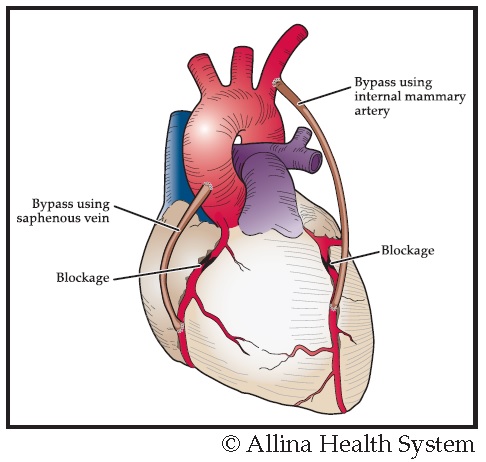
Coronary artery bypass surgery (CAB)
Coronary artery bypass surgery (CAB or CABG) helps more blood get to your heart.
If angioplasty and/or placing a stent does not improve your blood flow, you may need to have coronary artery bypass surgery.
This surgery helps more blood get to your heart. A blood vessel, usually from your leg and/or chest wall, is used to make another path for blood around your blocked artery to the heart muscle. The blockage will not be removed. You may hear the abbreviation CABG, which stands for coronary artery bypass graft.

Your health care provider uses a blood vessel to make a path for blood to flow around the blockage.
After CAB surgery questions and answers
Incision and other care
Before you leave the hospital, you will be given written instructions about wound care, lifting and driving restrictions and cardiac rehabilitation.
- You may notice swelling in the incision on your leg. This lasts about three weeks to three months after surgery.
- Keep your leg elevated (raised) as much as possible.
- When elevating your legs, use three to four pillows.
- Try to keep your ankles above your knees and your knees above your hips. This helps extra fluid in your legs get reabsorbed.
- If you have a swollen area at your chest incision, it will usually disappear in six weeks to three months.
Call your health care provider if you have concerns about incision care or show any of these signs:
- temperature of 100 F or higher
- tenderness or redness around incision
- increased evidence of pus-like (thick, creamy) drainage
It's important to see your regular health care provider after you leave the hospital. Some appointments will be made for you and others you may need to make from home. If the appointments are not already made, please make them. Your regular health care provider needs to know that this appointment is for a check-up after surgery.
Take your medicine on a routine schedule. If you miss a dose do not take twice as much the next time. Resume your schedule with the next dose.
Angina will likely be similar to the chest pain you had before surgery. This may feel like indigestion, a sharp and/or burning pain, an ache or numbness that begins in or spreads to your neck, jaw, throat, shoulder or back of your arms
Incisional pain is more constant. It occurs when you move suddenly or change positions. It can be relieved with pain medicines prescribed for you or by using pain relief measures that you used when you were in the hospital. If your pain continues and you are having difficulty deciding if your pain is incisional or angina, call your health care provider.
If you feel symptoms of angina, follow these steps unless your health care provider has given you other instructions:
- Take one nitroglycerin tablet or use one nitroglycerin spray. Sit for five minutes.
- If the angina goes away, rest for a while, then continue your normal routine.
- If the angina does not go away or gets worse, call 911 right away. Do not delay. Do not drive yourself to a hospital emergency room or urgent care.
Recovery
Recovering from your surgery or other treatment may take several weeks of steady progress before you feel like yourself again. You may feel a little weaker and tired when you arrive home. This is normal.
It is important to slowly increase your activity to regain your strength and independence. Be sure to get plenty of rest as you return to your normal activity level.
The following guidelines are for your recovery. Talk with your health care provider if you have any questions or concerns.
- Take all prescription medicines (such as aspirin or Plavix®) as directed by your doctor.
- Do not lift more than 10 pounds. In general, this lifting restriction lasts two weeks to three months. Ask your health care provider to recommend what is right for you.
- Take a shower every day with soap that doesn't contain perfume, lotion or moisturizer. Do not take a tub bath until your incisions are completely healed and there are no scabs. This usually takes two to four weeks.
- Do not smoke or use smokeless tobacco. Smoking increases your heart rate and blood pressure, and narrows your blood vessels. You are at an increased risk of heart attack, stroke and circulation problems. If you need help quitting smoking or using smokeless tobacco, please talk with your health care provider.
- Exercise at least three to five times a week. It is best for you to get some form of exercise every day, such as walking.
- Do not walk outdoors in very hot or cold weather. In extreme temperatures, do your walking in a shopping center or other community building.
- Try to walk on level surfaces in a safe area.
- Wait one hour after eating a moderate meal before doing exercise.
- You should be able to have a conversation while you exercise. If you are unable to do this, or if you have any problems, rest or slow your pace until you feel comfortable.
- Eat a well-balanced, healthful foods to promote healing. Eat frequent small meals and nutritious snacks, if you can't manage a large meal. Your appetite will gradually improve after recovery.
Allina Health locations for coronary artery bypass grafting
Experts at these hospitals perform coronary artery bypass grafting (CABG) surgery:
- Abbott Northwestern Hospital: Minneapolis Heart Institute®
Minneapolis, Minnesota - Mercy Hospital's Heart & Vascular Center
Coon Rapids, Minnesota - United Hospital's Nasseff Heart Center
St. Paul, Minnesota
Health library